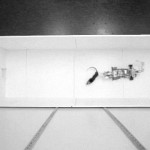Yesterday, my boyfriend and I went to the iFly Indoor Skydiving Vertical Wind Tunnel in the East Bay for his birthday. I was a little nervous on our way there, but it turned out to be pretty easy and a lot of fun.
After a quick lesson on body position, visitors get suited up in rad jumpsuits and head gear and then line up in the foyer of the vertical wind tunnel. One by one, newbie fliers enter the wind tunnel chamber by tucking in their arms and gently laying face first into the blasting wind. A flight instructor gently pulls you into the column and with slight adjustments of head, leg and arm position, you’re flying!
Indoor skydiving is supposed to mimic the feeling of a real skydiving free fall. In the iFLY setup, a 12-foot diameter wind tunnel can create a column of air shooting up at 150 mph. Likewise, after jumping out of a perfectly good plane, a skydiver feels the friction of air pushing up against his/her body.
The control room operator would change the wind tunnel speed depending on the size of the flier and, I assume, which tricks the instructor had in mind.
At the end of our flying session, the instructor did a little showing off. Amazing stuff- he was flipping, spinning, air-break dancing and zooming from the top of the chamber to the bottom. And, he made it look so darn easy.
This physics-education website explains a bit how he could pull off those acrobatics:
A skydiver typically reaches speeds of around 120 mph in the spread-eagle position. But he can reach speeds up to 200 mph if he orients his body with head pointing down, thereby decreasing A (where A is the cross-sectional area of the body perpendicular to the flow direction).
During free-fall a skydiver can perform a variety of acrobatic maneuvers such as spinning, moving forward, moving backward, just by changing the shape of his body to “catch” the wind a certain way. By doing this he is essentially changing the direction of the drag force acting on his body, much the same way airplane wings can be oriented to produce a desired motion for the plane.
The nice people at iFLY record your flight on video. Here’s a montage of our flights– no flips or Spiderman behavior, but you can see how much control the instructor has over his movements (and whomever he’s holding) in the air column.







That’s a really cool birthday present! Seems like you guys had fun :)
I went tandem sky-diving once, and all I remember of the free-fall part is that it went by in what felt like a couple of seconds, although it was actually more like 30…and the air rushing by was incredibly noisy, which I’m guessing it was here as well…We didn’t do any fancy acrobatics though.
Will have to try this out sometime!
Skydiving is a really good time.
I’m interested to try the faux version and see how it compares!
The wind tunnel was really loud, but we had ear plugs in under our helmets (which also covered our ears), so it wasn’t bad once we were all suited up. We got a quick lesson in some hand signals from the instructor (bent legs, straight legs, chip up, etc) so he could communicate to us during the flight.
It was lots of fun!